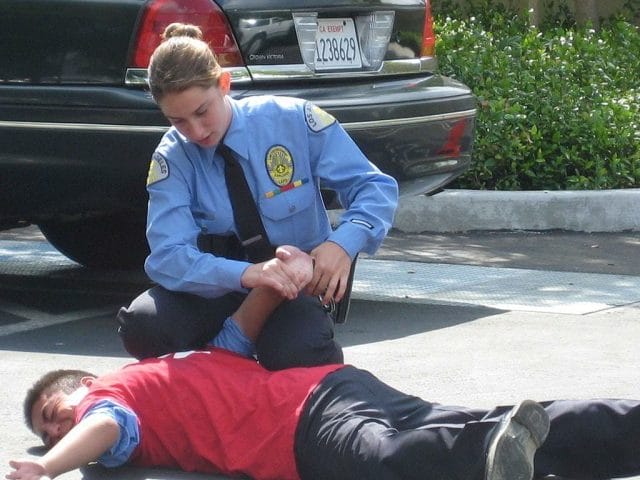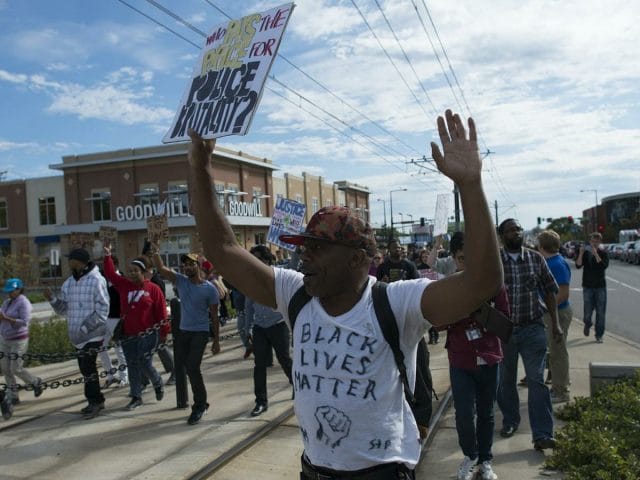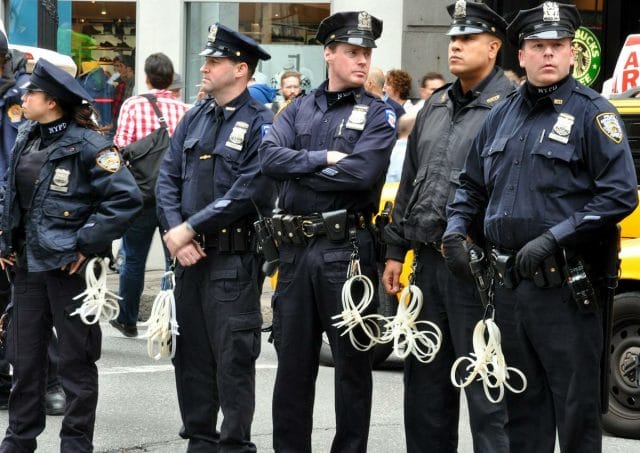Photo by Tony Webster
***
In the fall of 2013, the town council of Sorrento, Louisiana voted to abolish its own police department.
Despite the obvious drawbacks of going without law enforcement protection, the vote was unanimous.
Just two months earlier, a newly hired officer had gotten into a 100 mile-per-hour car wreck on the highway. It was later revealed that the same cop was already one of the town’s most zealous issuers of speeding tickets, hundreds of which were later thrown out in court.
But that was only the latest controversy to befall Sorrento’s men and women in blue. The previous spring, the department had been forced to fire two of its members—one, an assistant chief, for undisclosed reasons, and another, a rank-and-file officer for improperly using his Taser on a college student. This scandal, in turn, had come on the heels of three sexual harassment and racial discrimination lawsuits filed by former police officers against the chief of police himself.
Yet it was neither scandal nor lawsuit nor budget cut that finally compelled the town leaders to give their disreputable police department the axe. Instead, the death blow had come from a soft spoken man in Baton Rouge named Jerry Cronin.
Cronin is the general manager of Risk Management Inc., a for-profit risk pool that provides legal liability protection to two-thirds of the police departments in the state of Louisiana. As the organization ultimately responsible for the Sorrento Police Department’s ever-mounting legal bills, Cronin finally decided that enough was enough.
“We just didn’t feel like the supervision was adequate to protect our risk,” he explains. “They basically ignored underwriting regulations—the things we required them to do, they didn’t do.”
So Risk Management canceled the Sorrento P.D.’s coverage. Without legal liability insurance, a single patrol car accident, wrongful arrest, or workers’ compensation claim could bankrupt the government of the small town. In the face of such legal risk, the town council made the only choice they could. A month after Cronin’s decision, the department was gone.
Abolishing an unaccountable police agency with the stroke of a pen—police reform advocates can only dream of such power.
Over the last few years, police shootings in Ferguson, Chicago, Charleston, and countless other cities and towns across the country have brought unprecedented attention to the question of when police should use lethal force and how cities should respond to allegations of police misconduct. Though reformers often point to independent prosecutors and civilian review boards as possible arbiters of good policing, one unlikely change-agent has largely been left out of the conversation: the insurance company.
As the town of Sorrento shows, the financial corporations that provide legal liability insurance to police departments can sometimes succeed where activists and journalists fail. Because while police departments may be able to ignore protest and moral condemnation, they are less likely to overlook the appeal of lower insurance premiums or the threat of coverage termination. With ample financial resources, well-honed analytical capabilities, and a profit-driven focus on avoiding lawsuits, insurance companies might just be reform advocates’ best hope for bringing abusive police departments in line.
Surrogate Regulators
The basic premise behind law enforcement legal liability insurance is straight-forward: if a police department has insurance and it gets sued, the insurance company picks up the legal tab. This gives insurance companies a strong motivation to keep the departments that they insure out of court. In the words of John Rappaport, a law professor at the University of Chicago, this transforms the insurance companies into “surrogate regulators.”
As a rule, law enforcement agencies do not go out of their way to get sued. Police chiefs and city mayors certainly care about their legal liability. But according to Rappaport, insurance companies might care better.
“They have the profit motive,” he says. “The insurance company is the one that wants to turn around and put pressure on the police department to make it rank-and-file officers behave better.”
In contrast, city officials have “a more complicated profile,” he says.
Aside from not getting sued, a police chief may also want to minimize crime, to keep the police union happy, or to stick to the department’s budget.
Imagine a department is offered a particular training program that promises to improve officer behavior and reduce the risk of lawsuit. But let’s say it also costs tens of thousands of dollars and is likely to irk the cops on the street who feel like they’re being told how to do their jobs. A police chief will have to prioritize these various concerns. Minimizing legal liability may not always come out on top.
An insurance company, on the other hand, doesn’t care about the crime rate or the union or the city budget. It just wants to minimize payouts.
“It’s not too hard to imagine scenarios, especially where a city government is not working particularly well, where the insurance company might have the edge [at minimizing risk],” says Rappaport.
This runs against the conventional wisdom. Up until just a few decades ago, most towns actually prevented their police departments from buying liability insurance. After all, the entire premise of this type of coverage is that law enforcement agencies are insulated from the consequences of their own risky behavior.
Economists call this concept “moral hazard” and it applies to all types of insurance. Someone with a policy on their car is less likely to buy an alarm because if the car is broken into, the insurance company will pay for the new window. A bank with FDIC-backing is more likely to make risky investments, because they won’t face any downside if those lousy bets go bust. Likewise, an insured police department might take fewer steps to reduce incidents of wrongful arrest, illegal use-of-force, or sexual harassment.
But beginning in the 1960s, concerns about moral hazard began to give way to concerns about litigation. The Supreme Court bolstered the rights of suspects and defendants in rulings like Monroe v. Pape (which made it easier for citizens to sue city governments for civil rights violations) and Miranda v. Arizona (of “you have the right to remain silent” fame). Suddenly, police departments were exposed to a wave of potential lawsuits. Cities and towns across the country began turning to private insurance companies or banding together to form insurance pools. They did this, despite the fear that insured police departments might behave more recklessly, because they couldn’t afford not to.
Photo by Fibonacci Blue
But according to Rappaport, legal liability insurance arrangements may actually improve police department behavior because these contracts come with strings attached. If an insurer wants to stay in business, it has to be smart about encouraging, training, or browbeating the various departments that it insures into staying out of court.
Insurance companies do this with both carrots and sticks.
Preventing Loss By Any Means Necessary
In the insurance industry biz, these carrots and sticks are called “loss-prevention programs.” In a paper posted earlier this year, Rappaport details the lengths that these companies will go to in order to keep their insured departments from being sued. Some of the methods are more straight-forward than others.
In some cases, insurance companies will either hold or subsidize training programs. These can range from information sessions to sophisticated virtual reality simulators designed to teach police officers how to safely pursue a fleeing car or when (and when not) to shoot a suspect.
These simulators and training sessions serve a dual role: insurance companies teach their insured officers to behave in a way that will minimize litigation and police officers learn some valuable legal, technical, and administrative skills. Sometimes the departments get lower premiums too. Think of this like your health insurance company subsidizing your gym membership to keep you healthy.
But sometimes insurance companies will step beyond the role of useful noodge and directly into the business of writing police department policies. This can actually be useful for small town police departments, where staff are small and the level of expertise is low. A five-person sheriff department might very well welcome a bean counter from the insurance company offering a pre-written use-of-force guideline.
And when these various incentives and encouragements fail, insurance companies can always roll out the Sorrento option. According to an article in the Washington Post, city officials in Maywood, California, and Lincoln Heights, Ohio have disbanded their police departments at the behest of their insurers. Likewise, the towns of Waukeegan, Illinois and Irwindale, California were forced to enact major reforms.
Insurance companies can be very specific in their demands. In 2013, the police department in Niota, Tennessee was required to fire two of its officers. According to the town’s mayor, Niota’s municipal insurance provider had threatened to drop the town’s coverage if the two cops, who had been accused of beating a suspect, remained on the payroll.
Presumably, this was not an ethical decision, but an unfeeling, financial one.
“When activists and civil rights litigators and criminal defense lawyers talk about police behavior, it’s dripping with moral judgment,” says Rappaport, from the University of Chicago. “With the insurers, the language is very anodyne. It’s just ‘look, we have a problem, we’re experiencing a greater than average loss, and we need to control this loss.’”

Photo by 888bailbond
Police departments and city bureaucrats may ultimately be more receptive to that kind of language and logic, he says.
“It is a moral issue,” says Rappaport. “But in terms of optimizing outcomes on the ground, I’m not convinced that making it all a moral issue and passing moral judgment on the police…I don’t know if that’s the right way to go.”
Not A Silver Bullet
But if legal liability insurance is the right way to minimize alleged police misconduct, we still have a long way to go.
According to Joanna Schwartz, a professor at UCLA Law, while most law enforcement agencies rely on insurance, most of the big city police departments (“and, presumably, the vast majority of liability claims,” she writes) tend to go without.
Instead, many large cities will simply set aside a certain amount of money and build their own risk management programs and legal war chests in-house.
The decision to self-insure may be entirely rational. Insurance companies bring financial resources, risk-management expertise, and risk pooling opportunities to the table. Big cities have all three of these at their disposal. But for those who are looking to insurance companies as the de facto regulators of the police, this presents an obvious problem: insurance companies, writes Schwartz, “can only influence those law enforcement agencies that purchase insurance.”
John Rappaport from the University of Chicago has considered the possibility of an insurance mandate for police agencies. The idea is appealing: if insurance companies are better at regulating risk and the police departments most in need of risk management are self-insuring, why not force these go-it-alone law enforcement agencies to enter the market?
But Rappaport says he isn’t so sure that the relative success that insurance companies have had in keeping smaller police departments in line could be replicated at the big city level. Large police departments are complex organizations. Reducing misconduct across the board may take more than simply getting the incentives right at the top.
“I pity the insurance adjuster who has to penetrate the bureaucracy of the City of Chicago to get things done,” he says.
Plus, the benevolent influence of insurance companies can be selective.
After all, an insurance company is only interested in avoiding large legal payments. Thus, they are likely to encourage their insured police departments to avoid misconduct, but only the kind that might result in large legal payments. Avoiding less financially deleterious civil rights infringements is not likely to be a top priority.
Photo by Michael Fleshman
“Not all the things we call police misconduct are equal in the eyes of insurers,” says Rappaport. “With use-of-force and [vehicle] pursuit policies, we can expect insurers to be pretty good and pretty proactive on those issues.”
That’s because an unjustified shootings or a police-caused car wrecks are the stuff of multimillion dollar lawsuits. But not all misconduct packs such a big financial punch.
For example, stop-and-frisk.
“As big of a problem as it is on a societal level,” says Rappaport, “if you conduct an illegal stop-and-frisk, there’s no [financial] damages.”
That’s both because courts do not typically award substantial damages for illegal searches, but also because the people who are most commonly stopped and frisked are often the least likely to have ready access to legal representation. As a result, insurance companies often regard these types of official misconduct as “low dollar” infractions, he says.
As a financial calculation, reasonable search-and-seizure virtual reality simulators probably just aren’t worth the investment.
Moving the Needle
Still, there is some evidence that the insurance companies are pushing police departments in the direction of reform.
In 2015, a month after Freddie Gray was killed while in the custody of the Baltimore Police Department, John Chino, a California public entity insurance broker, told Risk & Insurance that police shootings now “lead the conversation” within the industry, even if they hadn’t yet had a major impact on premiums across the market.
And as high-profile police shootings encourage litigants to come out of the woodwork and prime jurors to distrust police officers, he predicted that “law enforcement claims are going to be way more expensive to defend.”
In the meantime, insurers are pushing cities to update their training and adopt body cameras. At the same time, many of the certification and training programs that insurance companies contract with have also revised their policies in recent years. The Commission on Accreditation for Law Enforcement Agencies (CALEA) may be the most prominent of these organizations. According to Daniel Shaw, a CALEA program manager, the non-profit used the Obama administration’s “21’st Century Policing” report and recent Department of Justice investigations on policing misconduct as its “benchmark” when it overhauled its law enforcement standards manual a year and a half ago.
“They are on alert now,” says John Rappaport. “[Insurers] woke up and thought, ‘aw crap, we’ve been pretty lax for a while.’”
According to Rappaport, the string of high-profile police shootings that have dominated headlines in recent years has had a subtle effect on the legal liability industry. Though the incidents occur all too regularly from a human perspective, they are still relatively rare as a matter of actuarial risk. The insurance industry is not facing a wave of claims resulting from the shooting of unarmed civilians.
But what these incidents (and the resulting protests) have done is reduced the level of trust between civilians and police. And that, he says, has a big financial impact.
“If tomorrow some cop shoots someone or beats someone up in Paris, Texas, well those potential jurors have been watching the TV and seeing what’s happening in Ferguson and Cleveland,” says Rappaport.
Today, more so than a few years ago, if a police officer goes to court, the jury may now be less likely to reflexively take him at his word. That has insurers in Paris, Texas, and everywhere else, worried. And when insurers get worried, police departments should take note.
Our next article examines the data to figure out what percentage of people don’t get married on Saturday. To get notified when we post it → join our email list.
![]()
Announcement: The Priceonomics Content Marketing Conference is on November 1 in San Francisco. Join speakers from Andreessen Horowitz, Slack, Thumbtack, Priceonomics and more.
Get your ticket here.






